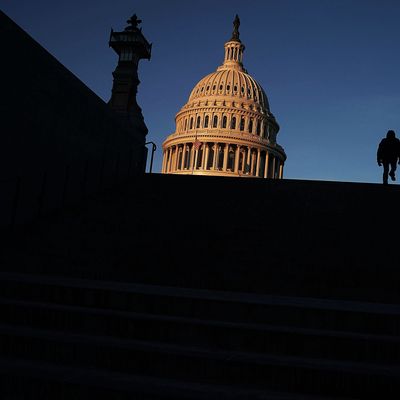
Beneath the midterm-election results was a sort of game-within-the-game in which the two parties struggled for control of the state gubernatorial and legislative offices that will, in most states, determine how the districts on the future electoral maps are drawn. On and immediately after November 6, it became apparent that Democrats had won seven net governorships and had flipped control of seven state legislative chambers. Less noted was the fact that four states (Colorado, Michigan, Ohio, and Utah) approved ballot measures transferring the map-drawing function from legislatures to independent commissions.
There are still a lot of variables at play before redistricting begins in 2021 (mostly notably 14 gubernatorial elections in 2019 and 2020, and state legislative contests nearly everywhere). But the semi-formed landscape is a lot better for Democrats than the one they faced ten years ago, as The Hill’s Reid Wilson explains at considerable length.
If the redistricting process were to happen today, Republicans would be in complete control of how district lines are drawn in 17 states, which hold a combined 163 seats in the House of Representatives. Democrats would be in complete control of just 10 states, accounting for 83 seats …
Commissions will draw boundaries in 10 states that send a combined 129 members to Congress.
The remaining 60 seats are from nine states with divided control of state government and six that have a single House member.
The Republican edge is far lower than it was in the last round of redistricting. In 2012, the GOP controlled the redrawing process in 22 states that accounted for 224 seats, while Democrats drew maps in nine states that sent 56 members to Congress.
And “control” can mean somewhat different things in different states. In Florida and Iowa, for example, there are state laws on redistricting that reduce legislative discretion. And sometimes courts intervene via litigation (e.g., the Pennsylvania Supreme Court decision that overturned the existing congressional district lines early in 2018, contributing significantly to national Democratic gains) or to resolve stalemates.
There are states where one party already controls so many House seats that controlling the redistricting process could simply mean hitting the point of diminishing returns. Democrats just took control in New York, where after this election they already hold 21 of 27 House seats, and in Illinois, where they now hold 13 of 18 seats. And it’s unclear how much better they can do in California, where they will now hold either 45 or 46 of the state’s 53 seats (depending on what happens in the 21st district, the country’s final unresolved House race, where a Democrat currently leads).
Some of the states where Republicans conducted extreme gerrymanders a decade ago — like Wisconsin and Virginia — now have Democratic governors. But as three political scientists writing for the Union of Concerned Scientists note, other states prone to the practice are still under iron GOP control:
[T]he North Carolina legislature has prohibited their (now Democratic) governor from vetoing districting maps, and citizens there just passed another version of a voter ID law that was struck down by the courts in 2016. The Tar Heel State will therefore remain a centerpiece in the battle for fair representation. Additionally, we look to Florida (which has some constitutional restraint on gerrymandering), Georgia and Texas as future focal points in the redistricting wars. Each of these states currently has unified (Republican) party control, competitive national elections, and will be adding House seats to their delegation after the Census. These are the very conditions that we found produced extreme gerrymanders in 2012.
It’s possible that before the next round of redistricting, the U.S. Supreme Court will take the opportunity it has repeatedly avoided by setting new constitutional limitations on partisan gerrymandering (though the Court as reshaped by Donald Trump is not terribly likely to do so). But all in all, the most important developments will continue to happen in elections, particularly as the moment of decision grows nigh. As Wilson notes, the redistricting landscape game is becoming expensive to play:
Groups like the Republican State Leadership Committee and the Democratic Legislative Campaign Committee shattered spending records this year, and more money is likely to pour into those down-ballot contests ahead of legislative contests in 2019 and 2020.
These investments will, of course, affect how specific states are governed, not just how its legislative maps are drawn. And 2020 in particular is going to be an election with very high immediate stakes. But the chance to influence political options a decade into the future is always going to be especially tempting.






























